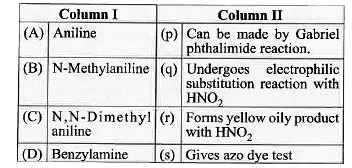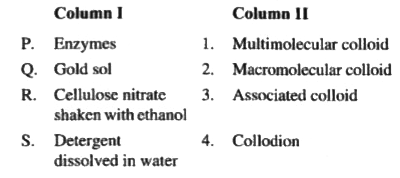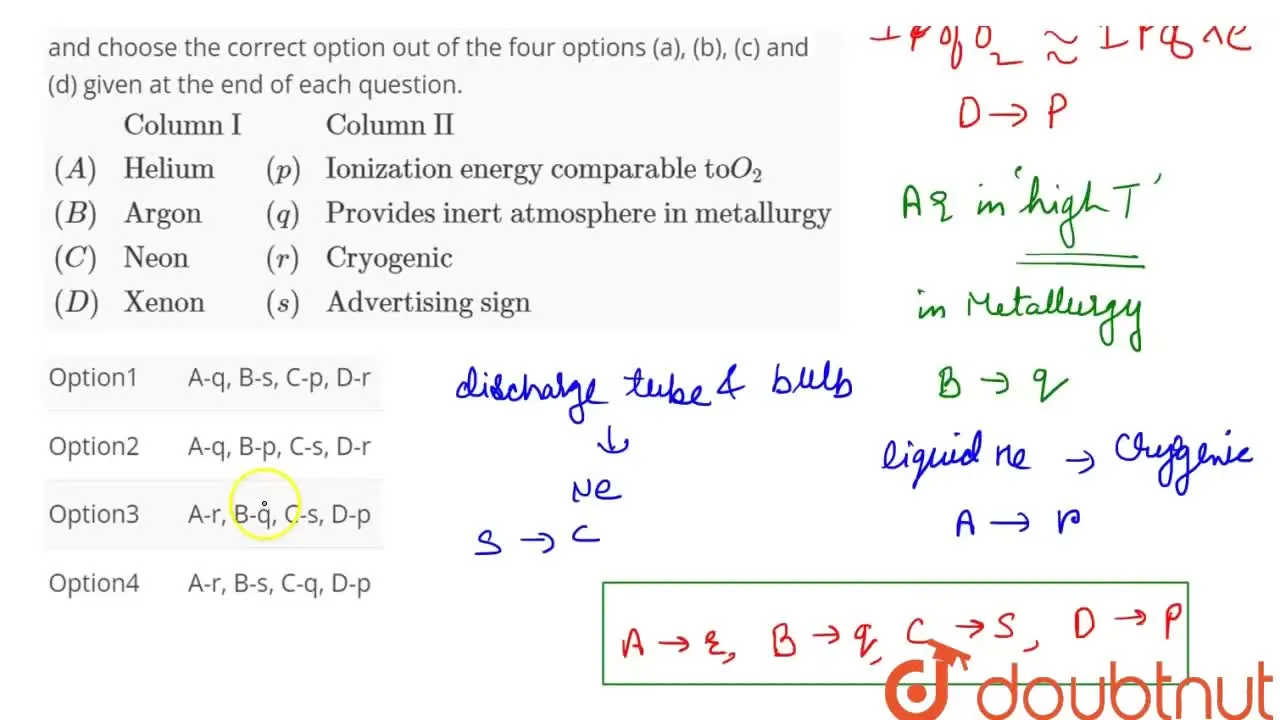Match the entries of column I with appropriate entries of coloumn II and choose the correct option out of the four options (a), (b), (c) and (d) given at the end of each question.
Column IColumn II(A)Helium(p)Ionization energy comparable toO2(B)Argon(q)Provides inert atmosphere in metallurgy(C)Neon(r)Cryogenic(D)Xenon(s)Advertising sign
A-q, B-s, C-p, D-r
A-q, B-p, C-s, D-r
A-r, B-q, C-s, D-p
A-r, B-s, C-q, D-p
The correct Answer is:C
Step by step video, text & image solution for Match the entries of column I with appropriate entries of coloumn II and choose the correct option out of the four options (a), (b), (c) and (d) given at the end of each question. {:(,"Column I",,"Column II"),((A),"Helium",(p),"Ionization energy comparable to"O_(2)),((B),"Argon",(q),"Provides inert atmosphere in metallurgy"),((C),"Neon",(r),"Cryogenic"),((D),"Xenon",(s),"Advertising sign"):} by Chemistry experts to help you in doubts & scoring excellent marks in Class 12 exams.
Related Playlists
- BOOK - PRADEEPCHAPTER - P-BLOCK ELEMENTS EXERCISE - ASSERTION AND REASON TYPE QUESTIONS6videos
P-BLOCK ELEMENTS
- BOOK - PRADEEPCHAPTER - P-BLOCK ELEMENTS EXERCISE - LONG ANSWER QUESTIONS8videos
P-BLOCK ELEMENTS
- BOOK - PRADEEPCHAPTER - P-BLOCK ELEMENTS EXERCISE - SHORT ANSWER QUESTIONS101videos
P-BLOCK ELEMENTS
- BOOK - PRADEEPCHAPTER - ORGANIC COMPOUNDS CONTAINING NITROGENEXERCISE - IMPORTANT QUESTIONS FOR BOARD EXAMINATION27videos
ORGANIC COMPOUNDS CONTAINING NITROGEN
- BOOK - PRADEEPCHAPTER - POLYMERSEXERCISE - IMPORTANT Questions (For Board Examination)27videos
POLYMERS
Similar Questions
Match the entries of column I with appropriate entries of column II and choose the correct option.
 View Solution
View SolutionMatch the entries of Column-I with appropriate entries of Column-II and choose the correct option out of the four option (A), (B), (C) and (D).
 View Solution
View SolutionMatch the entries of Column I with appropriate entries of Column II and select the correct option
 View Solution
View SolutionMatch the entries of Column I with appropriate entries of Column II and select the correct option.
 View Solution
View SolutionMatch the entries of column I with appropriate entries of column II and choose the correct option out of the four option (a), (b), (c), (d) given at the end of each question.
Column IColumn II(A) femto(p) 109(B) yotta(q) 10−15(C) giga(r) 10−18(D) atto(s) 1024View SolutionMatch the entries of column I with appropriate entries of column II and choose the correct option but of the four options (a), (b), (c ), (d) given at the end of each question.
Column IColumn II(A)Siderite(p)Zinc(B)Chalcocite(q)Aluminium(C)Calamine(r)Copper(D)Bauxine(s)IronView SolutionMatch the entries of column I with appropriate entries of coloumn II and choose the correct option out of the four options (a), (b), (c) and (d) given at the end of each question.
Column IColumn II(A)PCl5(p)Angular(B)IF7(q)Pyramidal(C)H3O+(r)Trigonal bipyramidal(D)ClO2(s)Pentagonal bipyramidalView SolutionMatch the entries of Column I with appropriate entries of Column II and chose the correct option out of the four options (a), (b), (c ) and (d) given at the end of each question.
Column IColumn II(A) Chlorine(p) Transition element(B) Helium(q) Highest electron gain enthalpy(C ) Iron(r ) Highest ionization enthalpy(D) Lithium(s) Strongest reducing agentView SolutionMatch the entries of column I with appropriate entries of column II and choose the correct option but of the four options (a), (b), (c ), (d) given at the end of each question.
Column IColumn II(A)Zone refining(p)Titanium(B)Mond's process(q)Lead(C)Liquation(r)Nickel(D)van - Arkel(s)GermaniumView SolutionMatch the entries in column I with those in column II and choose the correct combination from the options given :
 View Solution
View Solution


